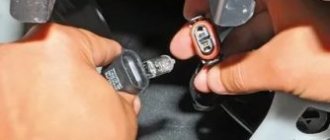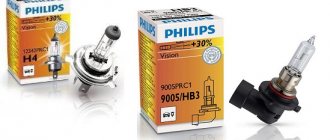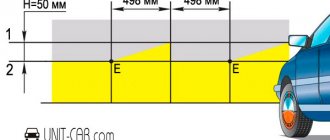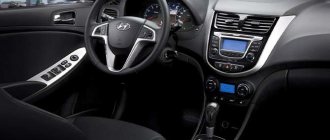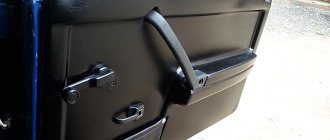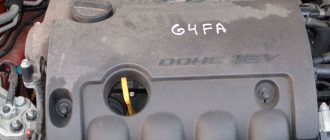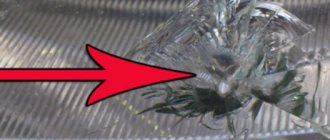Hyundai Solaris is a popular subcompact car produced by Hyundai Motors in the Russian Federation. The package was developed as an adaptive version of the Hyundai Accent for the Russian climate. Production was launched in 2010, and two generations of cars have been built in sedan and hatchback bodies.
The four-door sedan and five-door hatchback were produced in the Russian Federation until 2017 and each received two updates to the interior, power unit and body. For all assembly options, only one block headlights with halogen standard lamps were installed.
Dismantling and installation of headlights
Reinstallation of the optics unit is associated with tuning options, replacement of the ceiling or lamp. The headlight of the Hyundai Solaris is located at the corners of the car and is made in an elegant drop shape. The quality of standard lights meets the driver’s needs 100%; thanks to their favorable location, it is possible to effectively adjust the geometry of the light beam. The light is controlled by switching sensors on the dashboard.
Manual configuration remains an important advantage. The headlight can be adjusted to specific operating conditions depending on the changed ground clearance. As the ground clearance decreases, the angle of illumination of the road changes. Manual adjustment allows you to obtain optimal illumination of the road and roadside in any conditions. Removal and installation of the front headlight in the sedan configuration is carried out in stages:
- Disconnect the negative terminal from the battery.
- Remove the front bumper.
- Rotate the turn signal socket and remove it from the housing.
- Release the latch and disconnect the connector.
- The headlight mounting location will open - unscrew the four bolts with a 10mm wrench.
- Release the latch.
- Remove the headlight unit.
- Rotate the dirt boot.
- Disconnect the wire block, press the lock and remove the lamp.
After the work has been completed - tuning, replacing a burnt-out lamp, installing optics are carried out in the reverse order.
The shape of the headlight unit in the restyled version of the Hyundai sedan and in the hatchback configuration differs from the first generation, the principle of dismantling remains the same.
There are two ways to remove the rear light on a Solaris:
- Remove the trim if large-scale repairs are being made to the adjacent part of the body.
- Open the pocket in the casing, through which access to the optics is provided.
To remove the taillight you will need a 10mm wrench and good eyesight. Dismantling is carried out step by step.
- Disconnect power from the battery.
- Remove the power plug from the headlight unit.
- Use a wrench to unscrew the nuts.
- Slowly pull the headlight towards you against the installed studs.
- Remove the seat from the piston that presses the block to the wing.
After repair, replacement, tuning, reassemble in the reverse order.
Headlight design: features
The headlight is fixed at 4 points and mounted with three bolts and one special fastening clip. At the bottom of the headlight there are protrusions provided for the grooves of the bracket, with the help of which they are firmly attached to the car body. There are three types of light bulbs in lighting fixtures.
- High and low beam. Bulbs 50-65 W are spiral-shaped.
- Yellow light bulbs indicating turn signals.
- Dimensions: 5 W.
Under one cover in a common compartment there are turning and lighting headlights, and the marker light is in a separate compartment and is screwed into another hole. Regardless of the body type of the Hyundai Solaris, the location and shape of the headlights remain unchanged.
This is not affected by vehicle modification. Therefore, when choosing a lighting device to replace a Solaris, you do not have to look for individual optics specifically for a hatchback or a sedan.
Fog lights are installed in all trim levels, except for the regular Optima and Classic. Each 27 W fog light is an excellent functional addition to a set of standard headlights.
To reduce vibrations, the fog lamp is attached to a special plastic plate; it completely prevents or reduces the level of vibration created while the car is moving. The headlight is designed in such a way that it can be directed in different directions using a regulator and change the direction of light. The headlight has a whole set of wires with connectors.
The rear headlights differ from the front ones in shape depending on the body type and have three lighting devices: dimensions, brake lights and turn signals. All three lamps are interconnected and secured with bolts and special fixing clips.
Reflective lights on Solaris also differ depending on the car body. The license plate light for the hatchback is mounted directly into the bumper, while for the sedan it is installed in the trunk lid. Recently, it has become possible to install headlights with lenses on a Hyundai Solaris car. This is a lighting device with a special collecting lens. Its advantages are as follows:
- more efficient than conventional headlights, the largest part of the light falls on the road;
- excellent light distribution: does not dazzle oncoming drivers, does not create a bright blind spot;
- uniform distribution of light rays over the entire road surface;
- wider view of the road;
- is stylish and modern optics;
- possibility of installing xenon lens headlights.
When dismantling is necessary
Disassembly of optics and reinstallation of lamps or ceiling lamps is carried out in the following cases:
- Damage to the headlight surface. Large cracks occur after being hit by a stone thrown at speed from under the wheels of oncoming traffic. The part is being replaced.
- Natural surface wear. Small cracks appear on the headlight, which reduce the luminous flux by 20 - 50%. The optics are being polished and restored.
- The light bulb has burned out. The low and high beam in the Hyundai Solaris is provided by a standard 55/60 Volt halogen lamp. The part is being replaced.
- Tuning. Reinstallation of the standard light to an analogue one - xenon or LED. It is necessary to remove the Solaris headlight and improve the design.
How to change the low/high beam bulb on a Solaris
We evaluate the scope of work.
Practice shows that the low beam filament burns out more often than the high beam.
This is due to the fact that the low beam is used much more intensely. To save on lamps, you can install a set of LED daytime running lights. This is by the way, but changing a lamp on a Solaris is extremely easy, especially the right one.
This is done like this:
- Open the hood and remove the protective cover on the headlight unit. It turns counterclockwise and provides access to the H4 headlight lamp and the side light lamp.
Remove the cover from the headlight unit.
- We find the terminal block and disconnect it from the lamp.
Removing the power terminal from the low beam lamp.
- Now we find the spring retainer. It is movably fixed in the upper part of the cartridge, and its lower part must be disengaged from the reflector body.
The spring is out of the way, the lamp is removed.
- We remove the old lamp from the socket and insert a new one. Under no circumstances should you touch the bulb of a new lamp with your hands. If we touched it with our fingers, we need to wipe the flask with alcohol. It is better to carry out the entire operation of installing the lamp while wearing fabric gloves.
- The headlight assembly is assembled in reverse order.
This is interesting: Which ones are better and how to replace spark plugs for KIA Sportage 3 (Kia Sportage)
Removing the bulb from the left headlight is more difficult.
There may be difficulties with the left headlight. The fact is that immediately behind the headlight housing there is a fuse box, and behind it is a battery. Therefore, space is very limited.
Fuse block mounting bolt.
To avoid removing the fuses, you can use a surgical clamp as a manipulator, but in any case, the cover of the fuse box will have to be removed. Good luck to everyone and keep your headlights shining!
What kind of low beam lamps will we install?
The service life of the factory lamps on the Hyundai Solaris is also not outstanding, so after 20–30 thousand kilometers many people have to think about how to change the low and high beam bulbs.
Not so much “how”, but “what”, because the prices for H4 lamps are very different. First, let’s dot the i’s and figure out which lamps can be installed in the Hyundai Solaris optics in principle.
Types of lamps
Lamp H4 low and high beam.
By default, our car is equipped with a two-filament halogen lamp with an H4 standard base of 12 V and a power of 60W for high beam and 55W for low beam.
24-volt lamps with the same base can be more powerful - 75/70 W. The socket for this lamp is designated P43t. The complexity of the base and socket is due to the fact that each of the threads must be at a certain angle in relation to the diffuser and reflector. Only then will the light flux be directed and effective. In order not to confuse the position of the lamp during installation, there are tongues on the lamp base, and on the body of the headlamp there are recesses that need to be aligned and snapped into place.
LED lamps
Light from diode and regular halogen low beam lamps. Halogen on the left, diode on the right.
In general, diode lamps shine better. But they cost more.
Fog lights Hyundai Solaris
Hyundai solaris fog lights are included in the standard optics kit of any configuration, unlike DRLs, which are not included in the model range. The manufacturer installs single-pin H27W/2 lamps with an L-shaped base. The analogue is the GE-881 with a power of 21 W. Drivers have certain difficulties when choosing a replacement PTF, the reason is the shape of the base. The following models are suitable as an alternative:
- Narva 48054. Provides yellow, even light of increased power.
- PHILIPS H27W/2. A model close to xenon provides maximum beam range.
- KOITO WhiteBeam III. The model has a resource increased by 40% and provides a beam of maximum brightness.
Small tuning of headlights on Solaris
By installing “eyelashes” made of durable plastic on the main optics of the car (additional tuning of the headlights without compromising the lighting qualities), you will emphasize the individuality and belonging to the category of female drivers. Solaris headlights - tinted with a special film. Using this tuning element, make sure that the headlight output complies with acceptable standards and safety regulations. Proper tinting does not interfere with the illumination of the roadway and serves as additional protection against small stones from oncoming cars. Theoretically, it helps to avoid blinding oncoming drivers with headlights.
LED “teardrops” are a recently emerged type of tuning for vehicle exterior lighting. LED strips are mounted in the corners of the headlights located closer to the radiator grille. They visually increase the boundaries of the optics, creating the illusion of a sparkling “tear”. Improve visibility in front of the car hood in the dark. LED strips are installed on Hyundai Solaris headlights inside or outside the lighting unit. Can be used as additional running lights.
Xenon headlights are installed on the car for better illumination in the dark. Bi-xenon optics must comply with accepted standards for the brightness of the luminous flux. The lighting characteristics can be improved within the technical capabilities of the vehicle recommended by the manufacturer. Good luck on the roads!
> How to remove a headlight on a Hyundai Solaris
Improving the light on Hyundai solaris
The manufacturer has provided a certain type of lamps, which is allowed for the Hyundai Solaris hatchback and sedan. Replacing lights with more powerful analogues should be carried out taking into account the recommendations of the factory.
The following lamps are installed in the front headlight:
- Low/high beam - H4 halogen lamp, power 55-60 W.
- Front turn signal - PY21W lamp, 21 W power.
- Side lighting - W5W, power 5 W.
Separately installed on the package:
- front fog lamp;
- additional brake signal lamp;
- license plate light.
How to remove and install a headlight on a Hyundai Solaris
Author of the article: AutoKontact.ru
A burnt-out headlight on a Hyundai Solaris does not mean that the entire unit needs to be replaced. It is enough to replace the light bulb and the function of the lighting device will be restored. The same is true for the rear lights of a car. Disassembling the optics itself does not require much effort or time. But you will have to tinker with dismantling the front bumper (otherwise you won’t be able to get to the headlight unit).
The Hyundai Solaris headlight is an electrical device, and therefore requires compliance with basic safety rules. Before starting work, do not forget to disconnect the battery. Disconnect the lamp unit connector by lightly pressing the latch (it is more convenient to do this with a small screwdriver). The headlight on the Solaris is attached to the body with several bolts; you need to unscrew them and carefully remove the headlight, having previously removed it from the technological grooves.
The dismantled Solaris headlight is transferred to the table and placed on a piece of soft cloth. It is more convenient to carry out further work on replacing lamps on a desktop. Remove the protective cover made of transparent material and take out the burnt out light bulb. Perform a similar procedure with the side lamps.
The operation of dismantling the rear headlight units is less labor-intensive. After ensuring safety by disconnecting the negative terminal of the battery, remove the lower trunk panel. Disconnect the wires, unscrew the retaining nuts, remove the unit and replace the burnt out light bulb.
Make sure the new bulb matches the required wattage.
- The headlights for Hyundai Solaris are equipped with 55–60 W bulbs.
- Rear markers – 5 W.
The original headlight on the Hyundai Solaris is equipped with halogen bulbs. When installing a lamp of this design, be sure to use gloves to avoid leaving fingerprints on the glass. Otherwise, the light bulb may burn out prematurely. It’s better to play it safe and wipe the lamps with an alcohol-containing solution. Mount and install the headlights in the reverse order.
If the headlights are dim, it is recommended to replace the lamp immediately, without waiting until it completely burns out. To do this, it is not necessary to contact a service station. The necessary replacement work can also be carried out in a garage.
Turn signal bulbs with a power of 21 W are changed as follows. The side reflectors are removed from the grooves on the body. To replace just the light bulb, it is not necessary to disconnect the wire connector. If you need to replace the entire device, you will have to disconnect the wiring block. After installation, turn on the headlights and adjust the direction of the light flux. When carrying out repairs in the garage, it is convenient to navigate by the beam on the wall or gate.
Installation of bi-xenon headlights
The installation of bi-xenon headlight units helps to significantly improve road illumination. This type of lamp allows you to save battery capacity; the elements produce powerful white light with maximum beam length. Due to the presence of a dividing curtain, the direction of the light beam is adjusted according to the geometry. The bi-xenon headlight has the main elements in its design.
- Automatic switching to low/high beam.
- An additional lighting element is a side lamp.
When choosing lens optics, the following characteristics must be taken into account:
- Color temperature up to 5,000 is white light, close to daylight, allowed by traffic regulations for installation on cars.
- The xenon lamp must have a suitable base.
- The kit includes: bi-lens modules, decorative caps, a set of fasteners, a switch with a relay, and ignition units.
Xenon lights are connected to the vehicle's on-board electrical system through a xenon light ignition unit.
The procedure for replacing standard lights with bi-xenon lights goes through the following stages:
- Remove the headlights. Remove the cover by turning it counterclockwise.
- Remove the halogen low and high beam lamps and be sure to remove the size socket.
- Clean the headlight, remove the glass cover, and warm up the part.
- Install the lens module using fasteners and install seals.
- Install the diffuser and carry out initial adjustment.
- Determine the mounting locations for the ignition units. The module must be protected from moisture and dust.
- Secure the ignition blocks and secure the wires.
- Carry out wiring on the low beam relay.
- Mount the headlight and secure all optical elements.
- Adjust the luminous flux.
When connecting for the first time, the bi-xenon headlight may go out for 2-3 seconds; this is due to the warming up of the lamp, which received an impulse from the ignition unit.
Replacing the turn signal lamp
You can install a new lamp in the turn signal on Solaris yourself. The block is located on the car fender; for installation you will need a flat-head screwdriver and a 10mm wrench. Replacement is carried out in the following steps:
- Use a screwdriver to pry off the diffuser and pull out the block.
- Unplug the light bulb connector.
- Turn the socket counterclockwise.
- Pull out the electrical connector.
- Unclip the clip and pull out the light bulb.
- Replace the part with a similar one and reassemble the headlight in the reverse order.
The turn signal is considered one of the main elements of a car's lighting equipment, allowing for safe driving. For the absence of a lamp or an inoperative element, the driver faces a fine of 500 rubles.
Replacing rear lights (headlights) in Hyundai Solaris, photo and video instructions
Replacing the brake lamp Solaris hatchback The brake lamp is located in the lower part of the headlight.
You need to turn the lamp socket a quarter turn counterclockwise and remove the lamp socket from the headlight. Is it possible to remove the lamp from the socket in a similar way? Then install the new lamp into the socket by turning it a quarter clockwise.
Install the lamp socket into the headlight by turning it clockwise. Replacing the turn signal lamp Solaris hatchback Turn the turn signal lamp socket counterclockwise and remove the lamp from the headlight housing.
Turn the amber lamp counterclockwise and remove the lamp from the socket. Install the new turn signal lamp in reverse order.
How to remove the taillight of a Hyundai Solaris?
Replacing the reversing lamp Solaris hatchback Turn the reversing lamp socket counterclockwise a quarter turn and remove the lamp from the headlight. It is sold empty, without connectors and sockets; how to remove a rear light on a Hyundai Solaris we will remove them from the old one.
We start disassembling the old taillight by removing the latch, pressing it a little to the side so that it comes out of the latch from below and lifting it up: The cartridges are pulled out easily, just turn them counterclockwise. We transfer everything to the new flashlight. We install the new headlight on the car body, pay attention to the photo below, there is a clip circled in red, first you need to put the headlight on it and then push it inside. We tighten and tighten the nuts.
We connect the connector and check the operation of all the bulbs. We remove the socket with the lamp from the flashlight body.
Replacing rear lamps Solaris (hatchback)
Lightly pressing the lamp bulb, press it into the socket, turn it counterclockwise and remove it from the socket. The protrusions on the base of the combined brake signal and side light lamp are located at different levels and must fit into the corresponding grooves of the socket during installation.
Turn the turn signal lamp socket counterclockwise. The rear light uses a single-filament orange PY21W turn signal lamp.
Replacing rear lamps Hyundai Solaris
The lamp has asymmetrical protrusions on the body, and the grooves in its socket are also asymmetrical. Turn the fog lamp socket counterclockwise in the right reversing lamp.
The rear left lamp uses a red PR21W single-filament fog lamp. The rear right lamp uses a W16W single-filament reversing lamp. Replacing the bulb is similar to replacing the bulb in a hatchback taillight.
To remove the rear light... ...press the lock of the wire block... ...and disconnect the block from the light connector.
Replacing the marker lamp
The headlight lamp in the Hyundai Solaris is located in the headlight unit in the front headlight and in the rear light. Due to the specific configuration and location of the unit, replacing dimensions requires skill and additional equipment.
The front headlight uses a W5W type lamp with a power of 5 W for the side lights. From the driver's side, access to the unit is open; you can replace the parking lamp in a few minutes. On the other hand, there is no open access; it is necessary to dismantle or move the fuse box. Replacing the size lamp is carried out in stages:
- Disconnect the terminals from the battery,
- Remove the plastic cover by turning it counterclockwise.
- Remove the cartridge with the size from the block.
- Remove the lamp from the socket by unclipping the latches.
- Install a new part and mount the unit in the reverse order.
Replacing the second size lamp, access to which is limited by the fuse block, is carried out in a similar way. The lamp is removed with a clamp if it is possible to leave the fuses in place. If access is extremely limited, you can dismantle the unit and carry out work.
replacing headlights - Hyundai Solaris * GT * logbook of the year on TheDreamBag
The cover of the compartment for the side lights in the headlight is removed.
replacing the headlight on a Hyundai Solaris
We unscrew the light bulb and replace it with a new one. Removal procedure Before removing the headlight on a Solaris, disconnect the electrical connector that supplies power to the lamps. Pull the lamp out of the socket contact clamps by pulling on the bulb.
The instructions will be shown on one headlight, the second on Hyundai Solaris cars is dismantled identically. That's it, block headlight...
After replacement, installation of the headlight unit proceeds in the reverse order of removal. We install a new light bulb, if necessary.
Remove the bumper from its mountings. If it is necessary to remove the entire cartridge, you need to disconnect the wire block by pressing the latch.
If necessary, you can change the turn signal bulb, fog lights, reversing lights, side lights and brake lights.
After replacement, installation of the headlight unit proceeds in the reverse order of removal. As you can see, there is nothing difficult about removing and replacing light bulbs. Now let's move on to replacing the lamps in the turn signals located on the wings of the car. Replacing the turn signal bulbs First, you need to move the turn signal on the fender towards the front of the body.
Remove the pointer from the hole. Remove the socket from the indicator body, knowingly unscrewing it from the lamp. Pull the lamp out of the socket contact clamps by pulling on the bulb.
If necessary, install in the reverse order. If it is necessary to remove the entire cartridge, you need to disconnect the wire block by pressing the latch. Replacing lamps in the cabin In addition to the lamps on the car body, there is also light inside the car.
As for replacing the dashboard light bulbs and the dashboard as a whole, this is unnecessary. This is not a particularly necessary and cost-effective type of modernization, because on Solaris there are no problems with the design. Replacing the lamp on the navigation lamp is easy; you don’t even need any tools except your fingers, or a screwdriver.
Just wrap it in a rag so as not to scratch the lampshade and upholstery. Using a finger or a screwdriver, we pull out the plastic protection we need; there are two of them. We pull towards ourselves, starting from the side of the windshield and down.
Site navigation
As a result, the plastic gives in and comes out. Then everything is simple. We unscrew the light bulb and replace it with a new one.
Headlight fogging. Disassembly and repair.
Replacing headlights on a Hyundai Solaris The topic of replacing side light bulbs on a Hyundai Solaris is constantly debated in professional communities; it raises questions even among experienced car owners.
Replacing a Hyundai Solaris parking lamp or turn signal requires the ability to independently disassemble the parts. It is practically impossible to do without removing the bumper, especially from the front side. The cover of the compartment for the side lights in the headlight is removed. The battery is removed for ease of operation. For convenience, you can first remove the battery.
Removing the headlight
Next, the bolts securing the box are unscrewed; the key on the headlight is removed; the terminal is removed, it is moved to the side so that it does not interfere with work; At the last stage, you need to rock the socket with the side light lamp out of the flashlight housing. After replacement, we perform all operations in reverse order.
Tuning lighting for Hyundai Solaris Among the most frequently chosen tuning methods you can see: Not all operations can be carried out independently in a garage; it is more likely that you will be able to change only the taillights or install lighting on the bumper.
